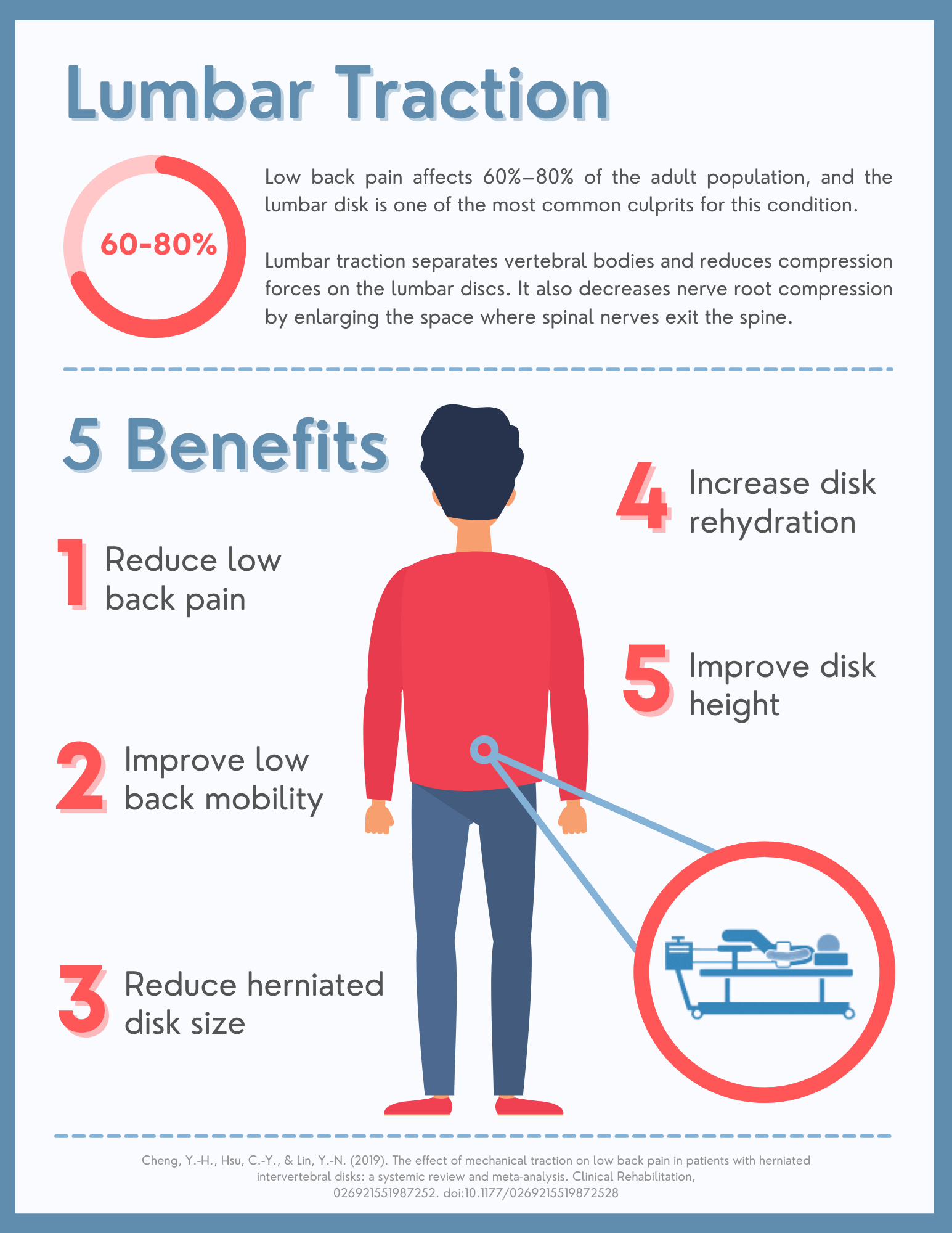Lumbar Traction Infographic For Your Patients
Reading time: 2 minutes
Do you ever wonder which patients may benefit from lumbar traction?
What is Lumbar Traction?
Lumbar traction helps manage radicular pain resulting from disc lesions, degeneration, or stenosis.
There is no consensus for the application of lumbar traction; clinicians must use their clinical judgment to determine the proper parameters. Most often, intermittent traction is applied on a sliding split table to reduce the loss of traction force due to friction.
The patient is typically lying supine with the knees and hips flexed to 90 degrees. Poundage can range from 20-50% of body weight, based upon patient body habitus and character of pain. The clinician should begin with the lowest amount needed to induce intervertebral separation. Higher levels of traction may not produce a more significant effect but do carry increased risk.
Duration is typically 10-20 minutes. Treatment frequency ranges from 2 times per week to daily. Clinicians will monitor response and adjust clinical doses as needed. (1)
Pro Tip: "Choosing between a prone or supine traction position may be directed by a number of factors including the patient's directional preference. Extension biased patients may benefit from traction in a prone position, while flexion biased patients would likely prefer supine traction with a knee bolster to increase flexion"
What Does Lumbar Traction Do?
Increase the intervertebral space
Stretch the posterior longitudinal vertebral ligament
Provide negative pressure drawing in a disc protrusion
Widening the intervertebral foramen
Distraction of the apophyseal joints. (2)
Pro Tip: Simply applying several seconds of strong manual traction to the legs of a patient lying prone, then supine can provide an early predictor of tolerance, benefit, and positioning preference.
Can I Use Traction For Acute Low Back Pain?
Absolutely! Here is a clinical prediction rule that has identified five predictors of lumbar disc patients who may benefit from traction. The presence of three or more of the following predictors more than doubles the likelihood of “greatly improving” with lumbar traction (increases response from 23.3% to 48.7%). (3)
Sudden onset of symptoms
Short duration of symptoms
No segmental hypomobility
Limited lumbar extension
Low fear-avoidance beliefs
An earlier study by Fritz et al. also identified four factors that help predict benefit from lumbar traction. (4)
Symptoms extend distal to the buttock
Signs of Nerve Root Compression
Peripheralization with extension
Positive Well Leg Raise
Both studies found that a lack of lumbar extension may be a common finding in patients that may benefit from traction. To learn more about directional preference for the lower back check out the Extension Biased LBP Protocol in ChiroUp.
Can I Use Traction For Chronic Low Back Pain?
Traction appears to be more successful in conjunction with multiple treatment methods, including spinal manipulation and mobilization. (5) Lumbar traction can also improve the pain and functional status immediately in patients with CLBP. (6,7) Providers must recognize clinical patterns allowing them to match patients' symptomatic presentations to specific traction strategies effectively.
There is a lack of standardization on when and when not to use lumbar traction. Several studies, including one systematic review, have found that various forms of lumbar traction can provide benefits for LBP when combined with other therapies. However, other large systematic reviews have questioned the benefit of lumbar traction for LBP with or without sciatica. (8-10) Despite awareness of conflicting data (plus generally poor reimbursement), the majority of providers disagree with these recommendations, and more than three-fourths of outpatient rehabilitation providers in the US continue to employ traction. (1) Some authors have suggested that providers may “recognize certain clinical patterns that allow them to [effectively] match patients’ symptomatic presentations to specific traction strategies.” (1)
Pro Tip: Even better, attach this infographic to your ChiroUp patient condition reports for any diagnoses that require traction.
As chiropractors, providing an exceptional patient experience is highly important to us. ChiroUp makes it easy with customized patient reports, a patient exercise app, and patient handouts like the one above. Get ready to improve patient compliance with ChiroUp.
-
T Bertelsman and B Steele. www.ChiroUp.com Accessed 06/29/2021. https://appsv2.chiroup.com/treatment/conditions/30
Pellecchia GL. Lumbar traction: a review of the literature. Journal of Orthopaedic & Sports Physical Therapy. 1994 Nov;20(5):262-7. (LEVEL 1A)
Hirayama K, Tsushima E, Arihara H, Omi Y. Developing a clinical prediction rule to identify patients with lumbar disc herniation who demonstrate short-term improvement with mechanical lumbar traction. Physical therapy research. 2019
Fritz JM, Lindsay W, Matheson JW, Brennan GP, Hunter SJ, Moffit SD, Swalberg A, Rodriquez B. Is there a subgroup of patients with low back pain likely to benefit from mechanical traction?: Results of a randomized clinical trial and subgrouping analysis. Spine. 2007 Dec 15;32(26):E793-800. Link
Mohamed HE, Elsayed WH, Aneis YM. THE COMBINED EFFECT OF MAITLAND SPINAL MOBILIZATION WITH MECHANICAL LUMBAR TRACTION IN PATIENTS WITH CHRONIC NON-SPECIFIC LOW BACK PAIN
Tanabe H, Akai M, Doi T, Arai S, Fujino K, Hayashi K. Immediate effect of mechanical lumbar traction in patients with chronic low back pain: A crossover, repeated measures, randomized controlled trial. Journal of Orthopaedic Science. 2021 Mar 27.
Tanović E, Čelik D, Omerović Ā, Omeragić VZ, Jaganjac A, Konjo H, Rovčanin E, Omerović H. Intermittent traction therapy in the treatment of chronic low back pain. Medicinski Glasnik. 2021 Feb 1;18(1).
Clarke J, Van Tulder M, Blomberg S, De Vet H, Van Der Heijden G, Bronfort G. Traction for low back pain with or without sciatica: an updated systematic review within the framework of the Cochrane collaboration. Spine. 2006 Jun 15;31(14):1591-9.
Wegner I, Widyahening IS, van Tulder MW, Blomberg SE, de Vet HC, Brønfort G, Bouter LM, van der Heijden GJ. Traction for low‐back pain with or without sciatica. Cochrane Database of Systematic Reviews. 2013(8).
van der Heijden GJ, Beurskens AJ, Koes BW, Assendelft WJ, de Vet HC, Bouter LM. The efficacy of traction for back and neck pain: a systematic, blinded review of randomized clinical trial methods. Physical therapy. 1995 Feb 1;75(2):93-104.


